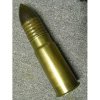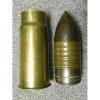jamespattman
Member
Hello and a Happy New Year,
I have had this projectile or "shell" since about June last year after being handed it by my grandad on the way to Bovington Tank Museum.
I have done a bit of research and all I could find was references to the Boys Anti-Tank Rifle, which i have heard a few stories about.
I would be gratefull if anyone could shed any light on what it is and was fired from.
The only distinguishing mark is an anchor on the brass sleve.
And correct me if im wrong, is the sleve to protect the barrel?
Many thanks,
I have had this projectile or "shell" since about June last year after being handed it by my grandad on the way to Bovington Tank Museum.
I have done a bit of research and all I could find was references to the Boys Anti-Tank Rifle, which i have heard a few stories about.
I would be gratefull if anyone could shed any light on what it is and was fired from.
The only distinguishing mark is an anchor on the brass sleve.
And correct me if im wrong, is the sleve to protect the barrel?
Many thanks,



